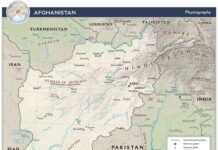Context
 Without doubt, all major stakeholders are now worried about the post 2014 Afghanistan. As the date of US withdrawal approaches quickly, many of the variables connected to the smooth transition are far from resolved. Meanwhile, the attention of western nations is increasingly diverted towards the affairs of Syria and Iran.
Without doubt, all major stakeholders are now worried about the post 2014 Afghanistan. As the date of US withdrawal approaches quickly, many of the variables connected to the smooth transition are far from resolved. Meanwhile, the attention of western nations is increasingly diverted towards the affairs of Syria and Iran.
Some of the interconnected factors complicating the Afghan situation are:
1. The strength and preparedness of the Afghan Security Forces to handle the security situation in the absence of NATO forces.
2. The scale of US military presence in the country beyond 2014.
3. The nature of security agreement between the US and Afghanistan, on which depends the American military footprint after 2014.
4. Afghan representation: the status of Afghan reconciliation and how it relates with the upcoming Afghan elections.
5. Who will be the next president of Afghanistan and what that signifies?
6. Addressing the role of regional players and managing their rivalries.
Amongst these, the most critical component is the Afghan representation. The simultaneous existence of Karzai government that came to power after 9/11, and the budding Afghan reconciliation, poses a unique dilemma. The challenge is how will these two elements of Afghan representation, which are the antithesis of each other, now merge and coexist. As US withdraws, the strategic thinking of Pakistan on Afghanistan is taking on addtional emphasis. The nations economic perils and turmoil in the Middle East are forcing the country to pivot towards Central Asia. However, the stability of Afghanistan is a key to the success of this strategy.Analysis
The Issue of Afghan Representation
If the upcoming elections were to decide the future dispensation of Afghanistan, then how does this relate with the Afghan reconciliation. Clearly, whoever wins in the elections will claim to be the true representative, and this is likely to produce more infighting if not properly handled. The smooth fusion of the existing establishment and Afghan Taliban is a critical objective of the Afghan reconciliation process. Achieving this goal is further complicated by the fact that there are no clear winners and losers to the conflict.
Moreover, the Afghan Taliban consider Karzai government to be illegitimate and have wanted to talk directly with the US. On the other hand, US for its part has conducted direct talks with the Taliban, most probably with the assistance of Pakistan. This, however, created a serious backlash from the Karzai administration, accusing the US of attempting to sideline his government. Some recent reports indicate that Taliban are now talking with the Afghan High Peace Council.
The Size of the US Presence, Reconciliation, And Afghan-US Security Agreement
The other puzzle connected with the political solution has to do with the size of American troops past 2014. One of the Afghan Taliban precondition for negotiations had to do with the complete withdrawal of foreign troops. Although some of the recent Taliban statements have shown more flexibility in this regard as well. Meanwhile, Karzai has used the pending status of forces agreement as leverage against the US. The more Americans are perceived as sidelining Karzai, the more his administration delays signing the agreement, which complicates the reconciliation and US withdrawal. At the same time, US has also countered Karzai’s bluff with the introduction of zero troops option.
Sensitivities of US Presence In Afghanistan
The size of US presence in Afghanistan is also a sensitive issue for Pakistan, Iran, China, India and Russia. One of the reasons for Pakistan’s seeming inability to develop a clear counter terrorism strategy has to do with this very factor. The country has two narratives related to the US presence in Afghanistan. One of them holds that as US withdraws, the extremism will start to taper down, as the raison detre for different extremist groups would cease to exist. The proponents of this school of thought deem the sooner US troops withdraw, the quicker the state of normalcy would return to the region, especially to Pakistan. The believers of this school perceive American presence in Afghanistan as threatening towards Pakistan, especially in the post Osama operation environment.
The other thinking considers the complete US withdrawal as risky for Pakistan. Embolden with their success in Afghanistan, the extremist groups may focus more of their efforts towards not only Pakistan and India, but also spread towards Central Asian republics, Iran, and other hot spots in the Middle East. Some of this is already at work with the reported presence of Pakistani Taliban in Syria.
Pakistan, India and Central Asia
In this context, the regional countries recognize that once US leaves, and even if it maintains a light foot print in Afghanistan, a lot will depend on Pakistan’s strategic thinking about the post 2014 environment. Meanwhile, Pakistan’s emerging posture appears to be comforting; it wants to facilitate a negotiated settlement in Afghanistan, as indicated by the release of Mullah Baradar. However, it does not seem to desire a complete return to the pre 9/11 configuration, which perhaps is not possible either. Towards this end, the country has already established regular contacts with the representatives of Northern Alliance. PM Nawaz Sharif’s visit to Turkey may also be a move towards easing concern in the Central Asian republics, and amongst Afghanistan’s non-Pushtun ethnicities, regarding Pakistan’s future thinking.
For its part, China, Pakistan’s strong ally, is also deepening its ties with Central Asian republics. The Chinese President made a trip to four Key Central Asian republics from September 3 to 13 before heading to the SCO meeting in Kyrgyzstan. China has been promoting its own version of Silk Route that rhymes well with Pakistan’s proposed Kashgar-Gwadar trade corridor and CASA 1000 electricity sharing project. However, many believe the inroad China is making in the energy sector of the region is occurring at the expense of India. While India’s ONGC had planned to buy 8.42% shares of Houston based ConocoPhillips in Kazakhstan, that deal has reportedly fallen in jeopardy because Astana used its preemptive right to buy those stakes instead. During President Xi’s visit to Kazakhstan in early September, the country agreed to sell China 8.33 percent of the offshore Caspian Sea oilfield for $5 billion.
The strongest concern regarding Pakistan’s intent will continue to come from the Indian quarters, and this is why the normalization of ties between the two is critical for the amicable solution in Afghanistan. Even a semblance of stability in Afghanistan could bring a new era of trade and economic boom for the country itself, Pakistan and the region. The energy and economic pressures, including turmoil in the Middle East, are forcing Pakistan to diversify its approach towards Afghanistan and to pivot towards Central Asia. However, if the stalemate continues in Afghanistan and the situation of Middle East continues to worsen, affairs could take a turn for the worse in South and Central Asia as well.



